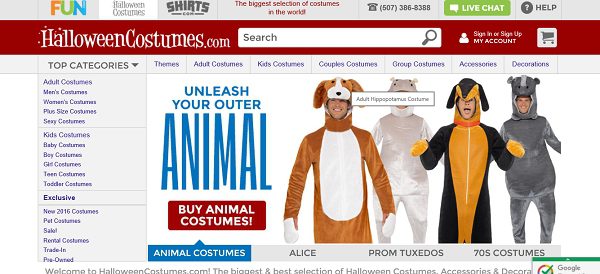When a once-a-year purchase cycle is built into your name, as it is for HalloweenCostumes.com, marketing’s task of retaining customers becomes extremely challenging. “People will buy a costume only once a year, so we need to ‘win back’ the customer every year,” said Mark Bietz, CMO of online retailer Fun.com, parent company of HalloweenCostumes.com.
Bietz and his marketing team use a number of tools and tactics to stay in touch with Fun.com’s customers throughout the year, such as providing tips for throwing a great party and reminders about the costume they purchased the previous year. But it’s a personalization solution from Qubit — which Fun.com deployed beginning in September 2015 — that is having the most dramatic impact.
Merchandising emails based both on a customer’s past purchases and items currently in shopping carts produced 10% to 15% conversion rate improvements compared to non-personalized emails. Customer segment and individual behavior data also are combined to populate Fun.com’s site pages with products that a customer is likely to be interested in. This personalization engine has helped boost conversions by 2.3%.
Advertisement
Warm Weather = Skimpier Costumes
Bietz is pleased with these results and is anxious to extend Fun.com’s personalization efforts even further. “There’s a ton more that we could be doing,” he said in an interview with Retail TouchPoints. “I see us doing a lot more personalization based on the kinds of offers customers have responded well to. For one person it might be free shipping, for another person it might be 20% off. I also see us getting into weather segmentation, marketing full-coverage versus partial-coverage costumes, based on whether it’s a cold-weather or a warm-weather part of the country.”
Fun.com is also seeking to extend its use of the Qubit solution’s personalization capabilities into other parts of the customer experience. “I see this going into the merchandising of our full category pages, using algorithms to rank the order of products that are displayed,” said Bietz. Calculations would be based on two factors. One is what similar customers purchased after viewing a group of products, similar to Amazon’s “People who bought this book also liked these titles.” The other factor affecting the product ranking would be each customer’s individual preferences.
“Personalization is going to be a big initiative for us for the foreseeable future,” Bietz noted. “As the technology advances, we’re going to want to test out new and different things that I don’t even know about yet.”









